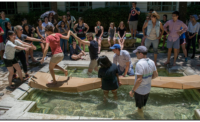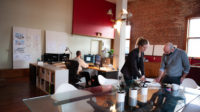In January 2015, the nonprofit organization Architecture for Humanity (AFH)—which helped architects serve populations in need, including victims of natural disasters—filed for bankruptcy and closed its doors. But many of its chapters continued to operate. Garrett Jacobs helped form an organization to support those chapters, now called the Open Architecture Collaborative, and in 2016 he was named its first director. A graduate of Tulane University’s architecture school, Jacobs worked as a set designer in New Orleans and taught design to high school students there before moving to the Bay Area in 2012.
He spoke to RECORD by phone in mid-October, as wildfires ravaged Northern California. “It’s a little intense right now,” Jacobs, 31, said from his office in Alameda. “We can see smoke over the Bay.”
Architectural Record: Does this tragedy present opportunities for your organization?
It could, but our focus now is not so much on disaster response as on finding new ways for architects to work with systemically marginalized communities.
So more training, less building?
Exactly.
AFH got a lot of publicity and won many awards, but it was never clear how much it actually accomplished.
The organization built many things, like the 19 soccer pitches and community centers across Africa that FIFA sponsored from 2008 to 2014. Mostly, though, it acted as a developer, directing philanthropic dollars to worthwhile projects.
How did you get involved?
I started working for AFH in 2012. At first I was a volunteer with the San Francisco chapter, setting up some small-scale projects like the renovation of part of a homeless shelter and the transformation of a dead-end street into a pocket park. Then I ran a national competition in which high school students submitted ideas for making their schools more sustainable. Eventually, AFH hired me fulltime as its outreach coordinator.
Were you there at the time of the bankruptcy?
Actually, in 2013, I went to work for a tech organization. I had left architecture completely, but I remained in contact with the AFH chapter leaders as a volunteer.
What do you think caused AFH to fail?
The bankruptcy is still in court, so people are hesitant to say anything about it. What I can say from my perspective is that the founders of AFH didn’t ask for help when they needed it. The organization was having trouble building systems internally to keep up with the number of projects it was undertaking in the field, and it could have used advice from outside experts.
How did you get involved the second time?
When I heard about the bankruptcy, I volunteered to break the news to all the chapter leaders and help them decide how they wanted to proceed. Throughout 2015, we had a lot of really open discussions about whether we should work together or go our own ways, and ultimately we decided to form a new organization. There are now 22 active chapters in 11 countries.
What have you been doing since you took the job?
I am collaborating with a community-development corporation in Oakland to train professionals to work with residents on small neighborhood-improvement projects: murals, a pedestrian-safety campaign, a pop-up library, etcetera. We’re helping people realize they have the power to change their surroundings.
You're starting very small.
Our other focus is a professional development program that we run within architecture firms. It’s about how architects can use their soft skills, like navigating building codes, along with their privilege, to help less-advantaged communities. We’re hoping to scale up these pilot programs in the Bay Area, and then share the lessons learned with the other chapters around the world.
How does your organization compare to AFH?
We’re much smaller. I’m the only staff member right now, and our budget is about $50,000 a year. AFH, at its peak, had about 45 people and a budget of over $10 million.
So your ambitions are smaller?
Personally, I think our ambitions are way bigger. I want to change the way architects think about their profession. I’d like them to find ways to serve many more people than architecture has traditionally served.







Post a comment to this article
Report Abusive Comment